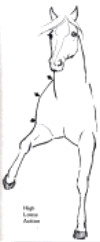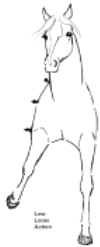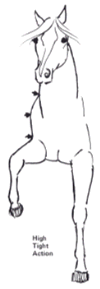Printed in the Peruvian Horse Review, Volume 2, Number 1, Spring 1975 |
||
| Termino | ||
| By Henry Curry, Jr., MD with drawings by Karen Zahlis |
||
| Termino is the most distinctive feature of the Peruvian Paso and is perhaps the most difficult to analyze. It is a complicated movement involving the entire forelimb and is executed so rapidly the human eye can only perceive it in fragments. Even the most experienced aficionados find it difficult to concisely describe the subtle variations. A neophyte will probably be confused about termino for at least a year and much of the problem lies in the lack of a uniform definition. When I became interested in Peruvian Pasos several years ago, the only consistent thing I heard about termino was that all horses of the breed have it. Some people say, "the more temino the better the horse" and other opinions are equally adamant that exaggerated termino is undesirable. References are made to "high termino" and "low termino" but these terms are bantered with no common point of reference. "High termino", to some means a movement originating in the shoulder but others refer to it as exaggerated action in the lower leg. | ||
| Janetta Michael and I were discussing breed standards a couple of years ago and after discovering that it is somewhat like describing a spiral staircase* without using your hands, we agreed on a reasonably concise description. | ||
| "Termino is an outward rolling of the front limbs during extension. It should originate in the shoulders and be associated with obvious "looseness" and fluidity in the movement of the shoulder girdle. This allows well gaited horses to reach out and forward in a smooth, graceful manner with minimal transmission of vertical force to the back. Horses devoid of this quality cannot extend smoothly and they frequently move in the front with short, "choppy" steps. Termino in the lower forelimb consists of anterior and lateral rotation around axes in the knee and fetlock. As the limb extends, the foot swings out in a lateral arc before returning squarely to the ground. The amount of vertical action varies considerably among individuals and must be evaluated in accord with the smoothness and elegance of gait. For example, a horse with limited vertical movement may be extremely smooth and extend well, but lack the crisp animation that is desirable in a show horse. Conversely, a horse with high action and poor extension or roughness of gait cannot be considered desirable. Ideally termino begins with a free, fluid rolling movement in the shoulders and is executed with good extension. The relationship between lateral and vertical action in the knee and fetlock should provide the appearance of brisk, harmonious animation with no appreciable sacrifice in smoothness." | ||
| This was subsequently incorporated into the Peruvian Paso Breed Standards and has received the approbation of several Peruvian breeders including Sr. Fernando Grana. Whether this definition gains popular acceptance remains to be seen. But it isn't important to quibble over definitions so long as everyone is aware of the importance of looseness in the shoulders as an absolute requisite for a Peruvian Paso to move rapidly and smoothly. A horse with flashy action in the lower forelimb will cover ground slowly or be rough in gait if there is not an accompanying freedom of movement in the upper limb. conversely, a horse may have meager action in the lower foreleg but still have smoothness and good reach because of the ability of the shoulder to swing easily in a forward lateral arc. | ||
| Several years ago a North American judge with little knowledge of Peruvian Pasos, gave a high award to a horse with high, eye-catching movement in the lower front legs but almost no lateral flexibility in the shoulders. The rider was able to conceal the roughness of the gait by not sitting down firmly in the saddle. The judge didn't ride any of the horses and probably didn't suspect what a rough unpleasant gait he was awarding as meritorious. The selection would undoubtedly have been different had he known to observe the shoulders for free lateral movement and not fixate entirely on "low termino". | ||
 |
 |
 |
| Example 1 Loose shoulders and good high termino. The optimal blend of esthetics and function is free lateral movement in the shoulder combined with crisply animated rotation lift and extension of the leg. A horse with this movement has the flashy action desirable for show and can also cover ground with speed and smoothness. |
Example 2 Loose shoulders, meager low termino. This action will enable a horse to move efficiently and smoothly but not command as much attention as the first example. |
Example 3 Tight shoulders, high action. Visually impressive, but not a good ride, this horse will either take short steps, be rough in gait, or both. |
| Although this discussion has dealt exclusively with action in the forelimbs it is not meant to belittle the importance of other factors in determining the quality of gait. The manner of impulsion provided by the hind limbs is also distinctive in the Peruvian Paso and will be the subject of future discussions. The sequence and tempo of limb movement as well as variables in conformation demand consideration, but are not within the scope of this article. | ||
| Probably the best method of analyzing termino and gait is with slow motion and stop action video analysis. Sr. Fernando Grana utilized a video tape record of the North American Championship show in Santa Rosa, California this year to conduct the judging seminar. It was tremendously effective and enabled him to communicate his observations to the group with ease and clarity. A more formal and extensive use of video would be invaluable in a post show analysis of the gait classes each year and over a number of years could provide a repository of material useful in studying genetic factors in determining gait characteristics. How would you like to see slow motion movies of Limenito, Carnaval or Caramelo in their prime? | ||
| * Spiral staircase -- a series of equidistant
steps built in an arc around a common vertical center with a
predetermined rise and fall in each complete circle. |
||